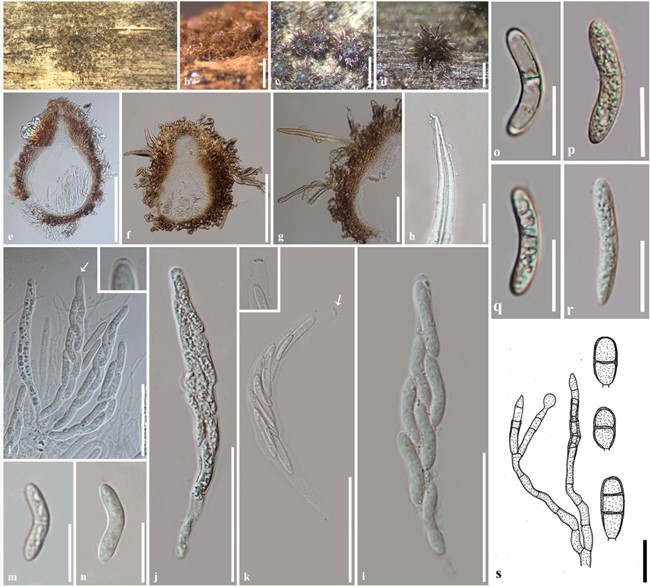Endophragmiella pallescens B. Sutton, Mycol. Pap. 132: 62 (1973)
MycoBank number: MB 313595; Index Fungorum number: IF 313595; Facesoffungi number: FoF 10139; Fig. 22s
Sexual morph: Undetermined. Asexual morph: Hyphomycetous. Colonies effuse, reddish brown, hairy, originating around effete stromata of immersed microfungi and spreading over the bark. Mycelium about 4 µm wide, immersed to superficial, composed of brown, septate, branched, smooth- walled hyphae. Conidiophores macronematous, mononematous, erect, simple or branched, flexuous, infrequently rigid, septate, light brown, becoming pale brown towards the apex, smooth-walled. Conidiogenous cells monoblastic, integrated, cylindrical, terminal, apex with 1–3 unflared annellations, pale brown. Conidia solitary, acrogenous, simple, ellipsoidal, pale brown, smooth-walled, 1–2-septate, not constricted at the septa, with a basal marginal frill (adapted from Sutton 1973).
Known hosts and distribution: On dead wood of Populus tremuloides in Canada (type locality) (Sutton 1973).
Notes: The mycelium of Endophragmiella pallescens associated with stromata of Cytospora chrysosperma on natural substrate in Manitoba, Canada (Sutton 1973). The hand-drawing is provided for the type species (Fig. 22s) based on Sutton (1973).

Fig. 22 Echinosphaeria canescens: a, b, e, h, i, l–n (F-SMH 2627); f, g, j, o, p (S-F 134887); c, d, k, q, r (S-F 134901). a Ascomata on host. b–d Solitary or scattered ascomata. e, f Ascomata in cross sec- tion with setae. g Peridium. h Seta. i Asci with paraphyses. j–l Asci. m–r Ascospores; Endophragmiella pallescens: s (redrawn from Sut- ton 1973). s Conidiophores with conidia. Notes: i. k. Arrows points to the apical ring of ascus. Scale bars: b–d = 500 µm, e. f = 200 µm, g = 100 µm, h. m–s = 20 µm, i–l = 50 µm
